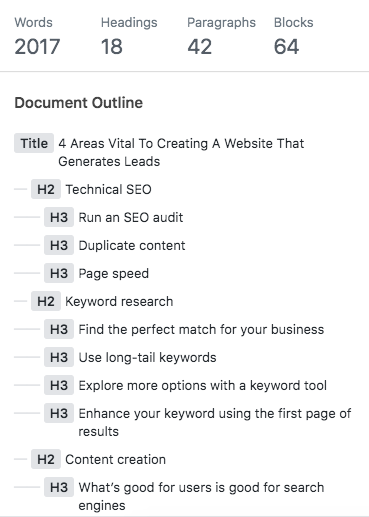
SEO content writing is a term that refers to producing optimized content that appears for target keywords. The process incorporates keyword research, SERP analysis, competitive analysis, content creation, and optimization.
Publishing search-engine-optimized content gives your posts a better chance of being found in the search results. Incorporate the following steps to create articles that rise to the top of the search results:
Want to skip the steps and have an SEO professional do it for you?
Table of Contents
ToggleChoose the keyword best suited to your needs and ability
The keyword you choose to target should present value to your website as well as be within your ranking ability. It won’t make sense to choose keywords with a low business value just for the sake of ranking your content on the first page.

Similarly, it’s a waste of time to publish content that no one will read because it’s too difficult to drive traffic to the page for its target search terms. The keywords you choose should be a blend of suitable search volume as well as within your realm of expertise to achieve a first-page position.
How do I determine if a keyword has business value?
Use the cost per click for a keyword to indicate whether other websites are making money from the traffic it drives. The logic behind this is simply that if there are people willing to pay money for every click then they are obviously making money from that traffic.
The higher the cost per click, the higher the inferred commercial value. Apart from the transactional value of the term, you should also consider the impact your content will have on its audience.
- Does your content make your visitor feel like they need your product or service?
- Does it further educate them on making a decision about a purchase?
- What stage of the buyer journey does your keyword address?
There’s more to assigning value to keywords for transactional intent. The purpose of your content can also be to create brand awareness and instill a sense of confidence in your prospective client.
The bottom line for choosing a keyword to target is that it moves your visitor closer to making a purchase decision.
Related reading: 10 Expert Tips For Writing Optimized Blog Posts
What’s an appropriate level of volume?
Adequate search volume will be different in every niche. Typically, B2B niches with high-ticket services require less volume to make a keyword profitable.
If you’re a lawyer or plastic surgeon, one client is worth thousands to your practice.
If you’re selling poop bags for dogs on your website, you’re going to need thousands of visitors in order to pay rent for the month.
Your conversion rate will determine the true value of a keyword and unfortunately, without data, you will need to make an educated guess at how many people you can move into your sales funnel from the total volume of monthly searches.
Gauge the competition
When you’re looking at potential keywords to target, filter out options based on the strength of the competing pages. You can get a good sense of how difficult your keyword will be to rank by looking at the domain authority of the top-ranking pages.
Unless you’re planning years into the future, eliminate keywords where your domain authority is dwarfed by every domain in the top 10 results. If you own an eCommerce website, you may be competing with retail giants like Amazon, Walmart and other high authority websites. In order to outrank those sites, it will take an enormous amount of time and resources.
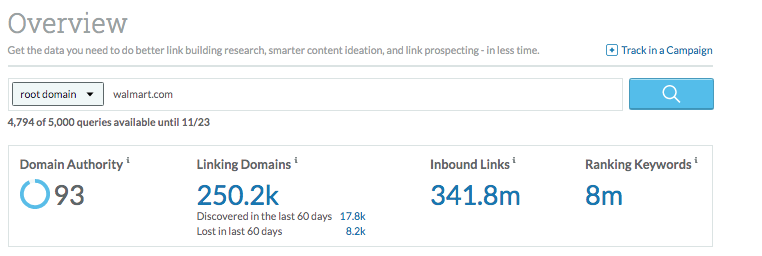
Look for openings in the SERP where websites with a similar domain authority are ranking. Keep in mind that Google ranks pages, not websites so you have the option of building links to your page to improve the page authority. That’s how you make up the difference in domain authority.
Choose your keyword based on a blend of factors
It’s rare to find a keyword that has low competition, with high volume and converts extremely well. They do exist but in most cases, you have to concede come qualities for others. Make your final decision on your keyword target by considering each of these factors and how they fit into your overall keyword strategy.
Establish search intent
One of the most important criteria for ranking highly in the SERPs is that your content accurately satisfies search intent. Identify and publish the content type and format that is best suited for users searching your keyword.
Establish what’s working to rank in the top positions by scanning the top 10 page titles on the SERP. The headlines can usually provide a strong indication of the content type that users are enjoying best.
When there’s a predominant type of content that appears in the search results, it’s an indication of what will work best to satisfy search intent. Identify which content type is the most dominant within the 10 organic search listings and plan on duplicating the same content type.
Analyze the top-ranking pages
In order to outrank the competition, you need to understand what is currently working to rank on the first page. You can’t make a “superior” piece of content without understanding what made it rank on the first page.
Analyze the top-ranking pages and determine what topics they cover and how deep into detail they go into. You can get a good idea of the outline a page has by scanning its subtitles.
Most articles will have the main points of a page highlighted by using headlines for each segment of their content. You can write them down to compare articles, or even cut and paste the content into your own CMS and see a detailed breakdown of topics. WordPress does an excellent job of summarizing the content you create on its HTML editor:
Take note of the internal and external links that they’ve used within their content as they may be valuable hints for optimization. There are some guides that rank extremely high, and the majority of their pages are external links to the various chapters of the topic.
When search engines crawl your page they will follow the links that you’ve built. If those pages are excellent resources for your topic that link will help to build the relevance of your page for satisfying search intent.
Publish 10X content
Once you’ve determined what the competition has published, aim to create content that is 10 times better than anything on the SERP. Make sure your article completely blows away the competition in every category. Provide more information and better multimedia with the intention of improving the user experience to a level that no other page can compete with.
How do I create 10X content?
After analyzing content on the top-ranking pages you should have an accurate idea of the topics that are covered and the level of depth that they’ve achieved. Your findings alone can be applied to, at the very least, provide a similar version.
Where you excel is to look at what these pages don’t have and including it in your content. If you’re pulling the best from every page you should already have a much better version of content when you put it all together.
Add depth of coverage
Keep adding to your findings by taking clues from the SERP. Use the questions in the PAA box to create more depth by answering commonly asked questions related to your keyword. The PAA box is infinite so if you continue to click on questions-more will continue to populate the box.
Add a completely new segment to your own content to boost the depth of coverage. The goal here is to provide a better solution to search intent, so keep your user in mind when you’re selecting questions that pertain to the topic you’re targeting.
Add new multimedia
Create a more enjoyable user experience by adding new multimedia to your content. Whatever the competition has used, don’t just one-up them, aim to outperform them to the point of embarrassment.
Make sure you have more images that explain more points. If the ranking page has five images, give yours at least 10. Provide a visual example for every subtopic that warrants a visual explanation. This will make your content easier to understand and digest.
Is there a video on any of the ranking pages? Make a video for users who prefer to watch and listen rather than read. Your content will appeal more to that specific segment of your audience that prefers video.
Be innovative and embed a slideshow. This can give your content a feature that isn’t as common, which separates your page from the masses. Whether it’s a slideshow, an audio file, or a gif., use whatever you believe will create a more enjoyable user experience for your audience.
Use original research and data
The more unique your content is with original statistics and real results, the more you differentiate your brand as an innovator. Visitors will trust your company and what’s more, your page will accumulate more backlinks as an original source of data.
The amplifiers in your industry are often looking for statistics when writing about topics. If you can supply original statistics from studies and surveys you’ve completed, the value of your content goes way up.
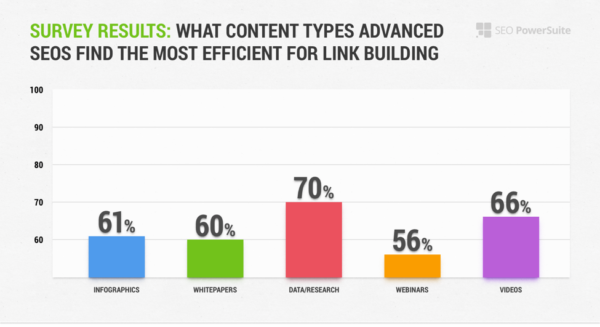
Optimize your page for performance
When you’ve finalized your draft, you will need to optimize your content to maximize the traffic you’ll receive. Not only do you want to be optimized for your target keyword, but you want to make sure your page has multiple ways to drive traffic from keyword-related searches.
Review content for the PAA box and featured snippet opportunities
The featured snippet appears for almost every question used in a search. Review your content for any opportunities where you can appear in a featured result.
If you’re analyzing keywords using a tool, you can find a list of the SERP features along with other keyword stats.
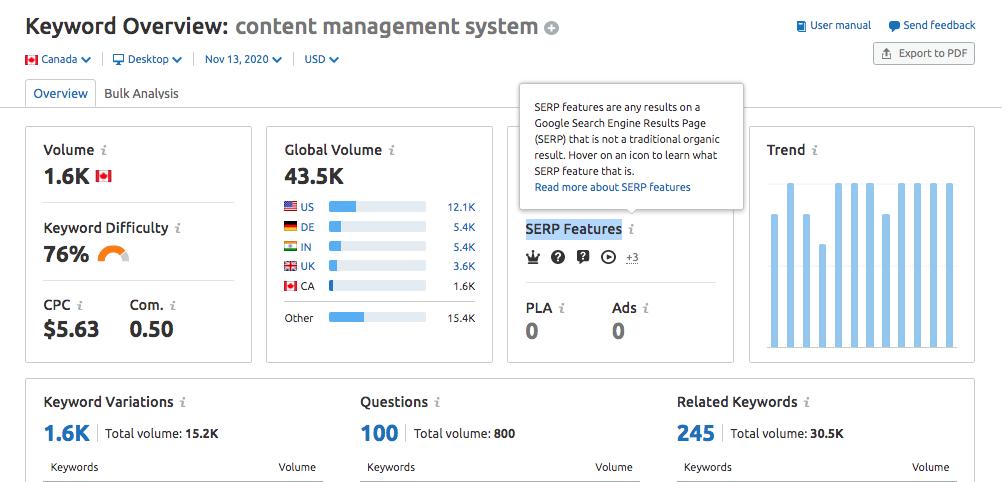
Look for questions and definitions as those are among the most common forms of snippets that appear in the SERP.
If you’ve followed the steps in this article, you may already have questions you found in the PAA box included in your content. As long you keep your answers short and succinct, you have a good chance of appearing in the feature.
Add structured data
Structured data markup enhances the optimization of your page. Schema.org has over 1300 defined entities that you can include in your page to make it easy for search engines to quickly process and establish the most important elements of your page.
Use the structured data markup helper to mark up your content. Aim for every possibility of receiving a rich result. The added search listing enhancement that rewards your page will attract more attention and ultimately more clicks and traffic to your site.
You can check here for a list of the items and the markup required to implement rich snippets in your content.
Use your target keyword in the metadata
Using your keyword in your metadata is among the oldest and most well-known forms of optimization for a reason; it has a big impact on your ranking for your target keyword.
Use your keyword in the title, image alt tags, and URL, a few times within the body of text as well as in your meta description. The meta description is the only place that search engines don’t specifically factor into your optimization-but it does impact how users see your search result.
Add secondary keywords
It’s never a bad idea to include some keyword variations a couple of times within your content. Using a keyword twice is probably enough to put it on a search engine’s radar. This adds context to your target keyword and creates more keyword options for search engines to rank your page.
When a page ranks in the number one position for a keyword, it usually ranks for hundreds of other terms and variations, according to a study by Ahrefs.
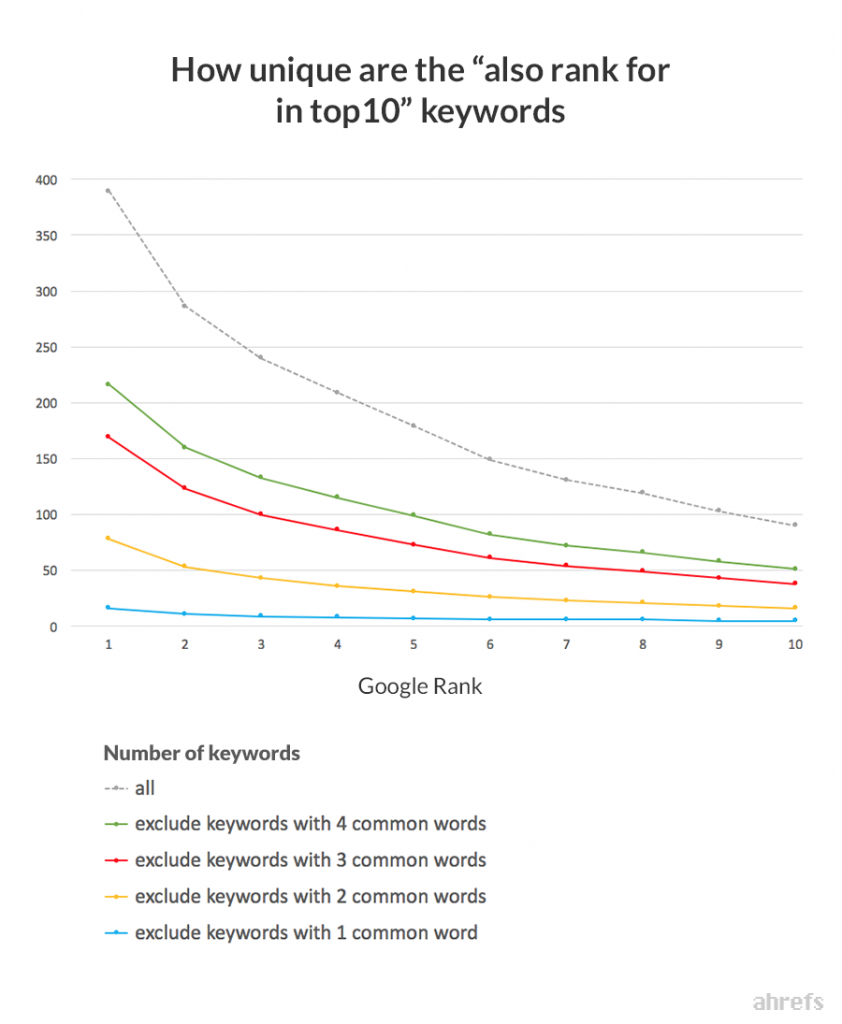
Give your page the greatest range of options when it comes to optimizing for keywords.
Finalize and publish
SEO content writing is not only a calculated approach to publishing top-notch content but is a way to publish content that drives traffic. Take the steps outlined in this article to produce content that captures the attention of your audience and is rewarded by search engines with a top ranking.

